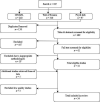Barriers and facilitators of disclosing domestic violence to the healthcare service: A systematic review of qualitative research
- PMID: 33440034
- PMCID: PMC8248429
- DOI: 10.1111/hsc.13282
Barriers and facilitators of disclosing domestic violence to the healthcare service: A systematic review of qualitative research
Abstract
Domestic violence victims are in frequent contact with the healthcare service yet rarely disclose. Therefore, it is critical to understand victims' experiences and perceptions regarding disclosure in healthcare settings. The goal of this review is to provide an updated synthesis of qualitative research identifying barriers and facilitators, advice, and positive and negative outcomes of adult victims' disclosure of domestic violence to healthcare professionals (HCPs). A systematic search of PsychINFO, CINAHL and Web of Science was conducted in January 2018. Thirty-four eligible studies were identified, including 783 domestic violence victims (781 females). Formal quality assessment indicated variable study quality. Barriers of disclosure included negative HCPs attitudes, victims' perceptions of safety and concerns about the consequences of disclosing. Facilitators of disclosing included a positive relationship with the HCP, HCPs directly asking victims about abuse, and HCPs ensuring that the environment is safe and disclosure is confidential. Victims advised increased awareness of HCPs reactions to disclosure and avoiding mirroring their perpetrators minimization. HCPs were encouraged to engage in direct questioning and maintain a supportive and secure environment. Positive and negative outcomes of abuse were identified, such as being able to leave the abuser or, on the other hand, the victims' situation not changing. Our results indicate that barriers for disclosure of domestic violence in healthcare settings persist despite the widespread implementation of policies and guidelines to counter them. Based on these findings, we provide recommendations for clinical practice and future research to help improve disclosure in healthcare settings.
Keywords: disclosure; domestic violence; healthcare personnel; healthcare service; qualitative research; systematic review; victims' experiences.
© 2021 The Authors. Health and Social Care in the Community published by John Wiley & Sons Ltd.
Conflict of interest statement
The authors declare no conflicts of interest.
Figures
Similar articles
-
Survivor, family and professional experiences of psychosocial interventions for sexual abuse and violence: a qualitative evidence synthesis.Cochrane Database Syst Rev. 2022 Oct 4;10(10):CD013648. doi: 10.1002/14651858.CD013648.pub2. Cochrane Database Syst Rev. 2022. PMID: 36194890 Free PMC article.
-
Systematic review of the perceptions and experiences of accessing health services by adult victims of domestic violence.Health Soc Care Community. 2008 Jan;16(1):16-30. doi: 10.1111/j.1365-2524.2007.00721.x. Health Soc Care Community. 2008. PMID: 18181812
-
Experiences of health professionals towards using mobile electrocardiogram (ECG) technology: A qualitative systematic review.J Clin Nurs. 2023 Jul;32(13-14):3205-3218. doi: 10.1111/jocn.16434. Epub 2022 Jun 28. J Clin Nurs. 2023. PMID: 35765173
-
A Systematic Review and Meta-Synthesis of Barriers and Facilitators of Help-Seeking Behaviors in South Asian Women Living in High-Income Countries who Have Experienced Domestic Violence: Perception of Domestic Violence Survivors and Service Providers.Trauma Violence Abuse. 2023 Dec;24(5):3187-3204. doi: 10.1177/15248380221126189. Epub 2022 Oct 15. Trauma Violence Abuse. 2023. PMID: 36250293 Free PMC article.
-
Exercise interventions and patient beliefs for people with hip, knee or hip and knee osteoarthritis: a mixed methods review.Cochrane Database Syst Rev. 2018 Apr 17;4(4):CD010842. doi: 10.1002/14651858.CD010842.pub2. Cochrane Database Syst Rev. 2018. PMID: 29664187 Free PMC article.
Cited by
-
Healthcare Providers' Perceptions and Experiences of Training to Respond to Violence against Women: Results from a Qualitative Study.Int J Environ Res Public Health. 2023 Feb 17;20(4):3606. doi: 10.3390/ijerph20043606. Int J Environ Res Public Health. 2023. PMID: 36834300 Free PMC article.
-
Attending to Power: Stakeholder Perspectives on Training Physicians to Address Intimate Partner Violence.Qual Health Res. 2025 Jul;35(8):837-846. doi: 10.1177/10497323241276409. Epub 2024 Oct 17. Qual Health Res. 2025. PMID: 39417667 Free PMC article.
-
"I Thought I Was Going to Die": Identifying Gaps in the Intimate Partner Violence Service Provision System for Black Women.J Interpers Violence. 2025 Mar 12:8862605251319020. doi: 10.1177/08862605251319020. Online ahead of print. J Interpers Violence. 2025. PMID: 40071839 Free PMC article.
-
Experience and impact of gender-based violence in Honiara, Solomon Islands: a cross-sectional study recording violence over a 12-month period.BMJ Open. 2023 Nov 16;13(11):e074042. doi: 10.1136/bmjopen-2023-074042. BMJ Open. 2023. PMID: 37973544 Free PMC article.
-
Barriers and Enablers Experienced by General Practitioners in Delivering Safe and Equitable Care during COVID-19: A Qualitative Investigation in Two Countries.Healthcare (Basel). 2023 Nov 21;11(23):3009. doi: 10.3390/healthcare11233009. Healthcare (Basel). 2023. PMID: 38063577 Free PMC article.
References
-
- Basile, K. C. , Hertz, M. F. , & Back, S. E. (2007). Intimate partner violence and sexual violence victimization assessment instruments for use in healthcare settings: Version 1. Centers for Disease Control and Prevention, National Center for Injury Prevention and Control. Retrieved from http://www.cdc.gov/violenceprevention/pdf/ipv/ipvandsvscreening.pdf
Publication types
MeSH terms
LinkOut - more resources
Full Text Sources
Other Literature Sources
Miscellaneous


